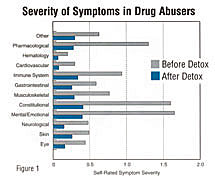Studies of the Narconon Drug Rehabilitation Program
Article from the Professionally Speaking newsletter publication of 1995
Each component of the Narconon program is designed to increase the abilities of the client.

One component of the Narconon Program is the detoxification (sauna sweat-out) program. This component is designed to mobilize and excrete fat-stored drug residuals. After completing the program, clients report marked improvements in mental acuity, depression and energy levels. These improvements in symptoms are shown in Figure 1.
Two-hundred and fifty clients having significant histories of drug abuse were treated with the detoxification program. Each client rated the severity of his symptoms-87 different symptoms in 14 categories-both before and after treatment. Ratings were on a scale of 0 (none) to 5 (severe) for each symptom. This graph in Figure 1 shows the average symptom severity before and after treatment. Marked improvements were noted in the chief complaints of this population.
Study in Spain Shows Dramatic Results
These results align with an independent study of the Narconon facilities done in Spain in 1985. In this study, an independent sociology group called Teonicos Asociados de Investigaci?n y Marketing (TAIM) evaluated the Narconon program. TAIM had also done studies on drug issues for the Ministry of Health, the Social Services Department of the Town Hall of Madrid, and the National Institute of Social Services of the Ministry of Labor and Social Security of Spain.
The Spanish study showed that 78.4% of the people who completed the Narconon Program remained off drugs. Overall, 69.2% of the participants admitted having committed robberies and 73% had been dealing drugs. Only 10.8% of the participants did not previously engage in criminal activity. The study revealed that no criminal activities were reported by any of the Narconon graduates after graduation.

Regarding relationships with their families, 67.6% of Narconon graduates said that their family situation was now much better, 29.7% said that it had changed for the better and only 2.7% said that it was the same. No one stated that it had changed for the worse.
Figure 2 shows:
- 21% Drug Use After the Narconon Program
- 0% Crime After the Narconon Program
Long-Term Survey Initiated
Long term recovery of substance abusers is the primary goal of the Narconon Program. Narconon International is currently doing a survey of clientele from its drug rehabilitation centers in the United States, including the residential facility in Los Angeles. The Narconon facility in Los Angeles has been delivering drug rehabilitation services for over 20 years.
Data has been compiled from a survey of the clients served at Narconon Los Angeles, during 1992 and 1993. Excluding clients currently on the program, the organization has delivered services to over 100 clients in this time. 42% of the clients who started at Narconon Los Angeles in these years did complete the full program. Of the clients who graduated in 1992 or 1993 from Narconon Los Angeles, 56% are known to be off drugs and doing well. We have lost track of many of these clients so this should be taken as a minimum estimate.
This study showed the importance of completing the full program. Clients could be separated into those who did only the withdrawal and/or detoxification components, clients who paid for the full program but did not complete it, and clients who graduated from the program. When all clients were combined, 33% were known to be off drugs and doing well. 37% of those who paid for the full program were known to be off drugs. In contrast, 56% of graduates were free of drugs. Again, these are minimum estimates of successful outcome as the status of many clients was not determined in this survey.